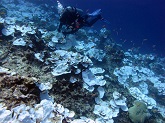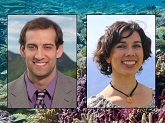- ABOUT US
- PROGRAM AREAS
- CONSERVATION APPROACH
- EDUCATION
- MULTIMEDIA
2019 Featured Stories
Nov
Coral Geography Bee

Geography Awareness Week, held every November, provides an opportunity to learn more about the study of places and the relationships that people have with their environments; as well as the ways geography affects our daily lives.
Community-Driven 'Opihi Restoration Proves Successful

Found only in Hawai'i, 'opihi is a marine limpet that lives suctioned onto rocks where the ocean meets the shoreline. It is a coveted local delicacy and staple of the native Hawai'ian diet. So when communities in East Maui started documenting declines in 'opihi populations, they took action.
Oct
Over $9.3 Million Awarded for Coral Reef Projects and Studies

NOAA Coral Reef Conservation Program Grants and Cooperative Agreements will address coral reef threats and restoration.
Alii Belau: Hello Palau

Every year, the U.S. Coral Reef Task Force — created by Executive Order in 1998 to coordinate coral reef conservation activities among government agencies at the national and local level — holds a meeting in a jurisdiction with coral reef ecosystems.
Sep
Corals and Estuaries — A Winning Partnership

National Estuaries Week, held every September, is a celebration aimed at increasing awareness of the country’s estuaries—such as the national estuarine research reserves—and encouraging people to become involved in the protection of these important natural resources.
Tracking and Managing Predicted Massive Coral Bleaching in Hawai‘i

Satellite data from the NOAA Coral Reef Watch program indicate coral reefs in the Northwestern Hawaiian Islands are experiencing a major bleaching event.
July
NOAA is celebrating Get into Your Sanctuary Days

In August, NOAA celebrates Get into Your Sanctuary Days, a nationwide event that encourages people to appreciate and learn more about the National Marine Sanctuary System.
NOAA Responds to Ongoing Outbreak of Coral Disease in Florida

Florida's coral reefs are experiencing a multi-year outbreak of stony coral tissue loss disease. Learn about the problem, what NOAA and partners are doing in response to the problem, and how you can help.
June
National Academies Study Offers Framework for Coral Reef Research and Recovery

Today, the National Academies of Sciences, Engineering, and Medicine released the second and final report for their study on Interventions to Increase the Resilience of Coral. The report, entitled A Decision Framework for Interventions to Increase the Persistence and Resilience of Coral, was commissioned by NOAA to help focus urgently-needed coral recovery efforts.
May
The Value Coral Reefs Provide against Hazards

In April, the U.S. Geological Survey released the results of a study on the role of coral reefs in reducing coastal hazard risks. The report, titled “Rigorously Valuing the Role of U.S. Coral Reefs in Coastal Hazard Risk Reduction,” looked at tools, valuation approaches, and economic information from various federal agencies.
New NOAA, Partner Buoy in American Samoa Opens Window into a Changing Ocean

NOAA and partners have launched a new buoy in Fagatele Bay within NOAA’s National Marine Sanctuary of American Samoa to measure the amount of carbon dioxide in the waters around a vibrant tropical coral reef ecosystem.
April
Sharing the Nationwide Task of Coral Reef Conservation

The U.S. Coral Reef Task Force - created by Executive Order in 1998 to coordinate coral reef conservation activities among government agencies at the national and local level - recently held its 41st meeting in Washington, DC.
March
Lessons from Coral Reefs for World Heritage Sites

Staff from NOAA's Coral Reef Watch led an assessment of the impacts of climate change on World Heritage coral reefs.
Over the River and Through the Coral

In 2015, the NOAA Coral Reef Conservation Program awarded funding to Florida Atlantic University to study the effects of the St. Lucie River on nearby corals in the Florida Reef Tract.
February
Translating Science to Management and Policy

Every year, graduate and professional school students travel to the Washington, D.C. area from around the country to learn more about ocean, coastal, and Great Lakes resource management and policy.
A Changing Climate through a Fisher’s Eye

In 2016, the NOAA Coral Reef Conservation Program awarded funding to the University of New Haven to assess the socioeconomic impacts of climate change on Puerto Rico’s coral reef fisheries.
About Us

The NOAA Coral Reef Conservation Program was established in 2000 by the Coral Reef Conservation Act. Headquartered in Silver Spring, Maryland, the program is part of NOAA's Office for Coastal Management.

The Coral Reef Information System (CoRIS) is the program's information portal that provides access to NOAA coral reef data and products.
Work With US
U.S. Coral Reef Task Force
Funding Opportunities
Employment
Fellowship Program
Contracting Assistance
Graphic Identifier
Featured Stories Archive

Access the archive of featured stories here...
Feedback
Thank you for visiting NOAA’s Coral Reef Conservation Program online. Please take our website satisfaction survey. We welcome your ideas, comments, and feedback. Questions? Email coralreef@noaa.gov.
Stay Connected
Contact Us
NOAA’s Coral Reef Conservation Program
SSMC4, 10th Floor
1305 East West Highway
Silver Spring, MD 20910
coralreef@noaa.gov
